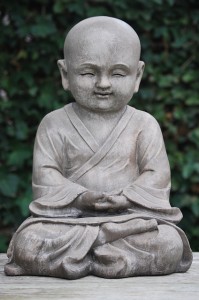
The practices of acceptance and non-attachment are critical to Zen and Buddhist practice – but they are easily misunderstood.
It can sound like we’re being asked not to care about things, or not to try to change things for the better. Fortunately, this is not what Zen means by acceptance or non-attachment, because 1) it’s impossible (or psychologically and spiritually damaging) not to care, and 2) trying to change things for the better is the bodhisattva path itself!
So what does it mean to practice acceptance and non-attachment?
Essentially, it means we stop resisting the way things are, and then we act in the world without tying everything back to our sense of self.
Notice that this way of describing our practice points out what we “stop” and what we “do without.” Basically, we stop doing things that are ineffective and harmful rather than trying to do something special. It’s not that we work ourselves into some noble state where we deny our preferences and accept unacceptable things with saintly equanimity. It’s not that we float through the world, swaddled in ambivalence so we never become invested in a particular outcome, and avoid making any mistakes. If we managed to do these “special” practices, we’d be – as the ancient Zen masters would say – “living in a demon’s cave in the black mountains,” or stuck in duality.
Of course, it’s awfully tempting to adopt a special attitude in our practice so the world doesn’t hurt us so much. There is a measure of cold comfort to be found in washing our hands of the whole worldly affair. If we can manage to create a point of view where nothing really matters to us, we’ll experience a whole lot less disappointment and worry.
You can tell someone is stuck in dualistic, “special” practice when they counsel you to feel better after a loss because “everything is impermanent anyway,” or when they claim to be resigned to our society’s destruction through global warming because “everything is empty and all is illusion.”
Zen is a bodhisattva path, which means that to practice it fully we must aspire to the fourfold bodhisattva vow:
Beings are numberless, I vow to free them
Delusions are inexhaustible, I vow to end them
Dharma Gates are boundless, I vow to enter them
The Buddha Way is unsurpassable, I vow to embody it
Does this sound like the path of someone who doesn’t care? Does it sound like the path of someone who isn’t going to try to change things? Quite the opposite. Ultimately our path invites us to care so much we are happy to sacrifice our own lives in order to benefit others, and to tirelessly keep trying to change things for the better as long as we’re alive – and, if it turns out we exist for multiple lifetimes, we keep trying to change things in every lifetime until the end of time itself.
How does this bodhisattva aspiration line up with acceptance and non-attachment? I admit, the whole question can make you crazy. Intellectually, it just doesn’t make any sense at all. I resisted really practicing acceptance and non-attachment for many years because, even though I wanted to be free of my suffering, I sure as hell wasn’t going to do it by abandoning my concern for the world.
Here’s the key: you are right to doubt what you think it means. This is a phrase my Dharma grandmother, Roshi Jiyu Kennett, used to use. For the word “it” you can substitute any Zen teaching or practice that doesn’t sit right with you. When your mind, intuition, or moral sense rebels against a teaching (or if it just leaves you profoundly confused), trust yourself! But then, rather than rejecting or avoiding the teaching, open your mind back up and ask, “What am I missing? What assumptions am I making? What else might this teaching be about?”
This isn’t to say that every single Zen teaching and practice is Ultimately True and Right, and that you only have your own ignorance to blame if you don’t get it. That’s dogmatism. Rather, the phrase “you are right to doubt what you think it means” is an open invitation to expand your mind and experience. You never have to swallow anything just because it’s Zen or Buddhist, but I’m a pretty skeptical person and over 20 years of practice I’ve yet to encounter a teaching in this tradition from which I couldn’t learn something.
So… go ahead and trust your misgivings. The Zen instruction to cultivate acceptance and non-attachment can’t be about not caring, or not trying to change things. So what does this practice actually involve, and how does it help us walk the bodhisattva path without getting overwhelmed psychologically and emotionally by suffering and impermanence?
Let’s return the language I prefer: we stop resisting the way things are and then we act in the world without tying everything back to our sense of self. Both of these phrases describe how we engage the present moment with our whole body, mind, and heart. They describe our subjective experience as a human being. They are not moral principles. They don’t work that way.
If “stop resisting the way things are” and “act in the world without tying everything back to our sense of self” were moral principles, our practice would look like this: We would encounter some difficulty. We would remind ourselves of the first principle, “stop resisting the way things are,” and do our very best to follow it. We would do this because we want to overcome our difficulty, and the powers-that-be have told us the best way to do this is to “stop resisting the way things are.” Once we have stopped resisting things as they are, we would know we were “in good” with God, or the Divine, or whatever forces are governing the universe, and things would start to go our way. Then we would try to act in the world without tying everything back to our sense of self – doing our best not to personally care too much about any particular outcome – because caring too much would jinx our winning streak.
When we practice in order to control the world, our feelings, or the good will of forces greater than us, the results are usually dissatisfying. Even though we’ve stopped resisting the way things are, they often still suck, and we still feel that they suck. Even though we’ve tried to act without self-concern, things don’t change the way we’d like them to. The worst thing about practicing this way, however, is that it distracts us from the real practice – the practice that is actually liberating.
Here’s an example of what it feels like to engage the present moment and stop resisting the way things are:
I take a moment to be still, putting aside all activities in order to be aware of my own experience. I turn my attention toward my pervasive (or sometimes acute) feeling of dukkha – that is, the feeling of being dissatisfied with my existence, or the way the world is. If the dukkha is acute, I feel a nauseating tightness in my gut and chest as I strenuously object to whatever frustration, pain, misfortune, loss, or injustice I am facing. If the dukkha is subtle, I feel a pervasive sense of unease, as if something’s not quite right. I may also feel a sense of waiting, as if my life isn’t really happening yet, or now’s not quite the time to fully embrace it.
The etymology of the term “dukkha” may give some insight into the subtle nature of this experience. In the notes to his translation of The Bhagavad Gita, Winthrop Sargeant explains the historical roots of duḥkha and its antonym sukha:
“It is perhaps amusing to note the etymology of the words sukha (pleasure, comfort, bliss) and duḥkha (misery, unhappiness, pain). The ancient Aryans who brought the Sanskrit language to India were a nomadic, horse- and cattle-breeding people who travelled in horse- or ox-drawn vehicles. Su and dus are prefixes indicating good or bad. The word kha, in later Sanskrit meaning ‘sky,’ ‘ether,’ or ‘space,’ was originally the word for ‘hole,’ particularly an axle hole of one of the Aryan’s vehicles. Thus sukha … meant, originally, ‘having a good axle hole,’ while duhkha meant ‘having a poor axle hole,’ leading to discomfort.” (SUNY Press, 2009, p. 303)
As I check in with myself, then, I recognize the sense of discomfort and unease I feel about my life. It is this dukkha that keeps me from feeling fully alive and authentic. It causes me to hold everything at arm’s length while I figure out what’s going on, or leads me to struggle to put everything right so the discomfort will go away.
The thing is, I never manage to figure everything out with my mind, let alone get everything permanently fixed so my ride is perfectly smooth. Ever. In the back of mind, however, I hold on to the hope that relief is right around the corner as long as I keep busy. (Maybe you react differently, and feel despair or become depressed, but the core of your problem is still dukkha.)
In the moment, I allow myself to fully recognize and feel my dukkha. It is an experience of my body, mind, and heart – not just an idea.
Then I invite myself to give it up. After all, it’s dukkha is just an attitude I’m taking toward my experience. In terms of how I feel about myself, I notice how limited, unmindful, selfish, silly, hopeless, irresponsible, unlikeable, predictable, etc. I think I am, and then I invite myself to say, “You’re okay.” I say this to myself like a kind parent would say it to a child, making it a comment on my fundamental worthiness as a human being, not an evaluation of where I rank on the human scale of success. I refuse to postpone taking my place in the world because I’m not perfect. I am just the way I am, fundamentally no better or worse than anyone else. To my long list of proposed self-improvements I say, “Who really cares?” I dare to commit the sin of fully accepting my lame-ass self even though I’m nowhere near meeting my own ideals.
Then, in terms of how I feel about life “outside” of myself, I notice the ways in which my life feels unacceptable, and resign myself to being fully present for life in spite of the pervasive inadequacy of my situation…












